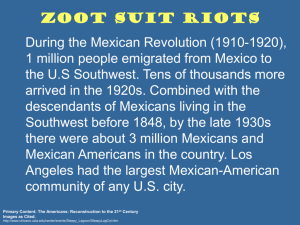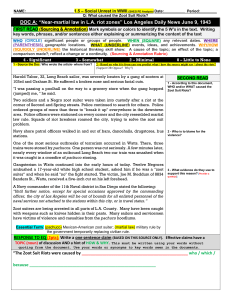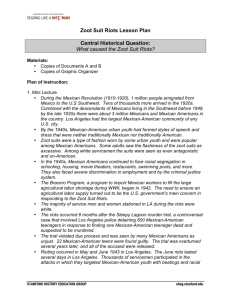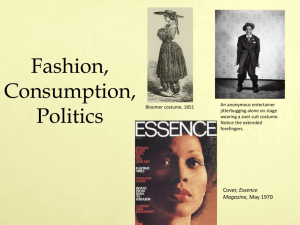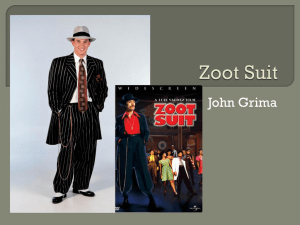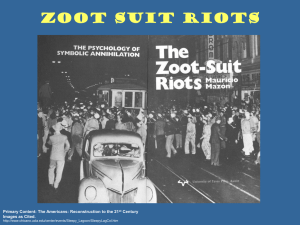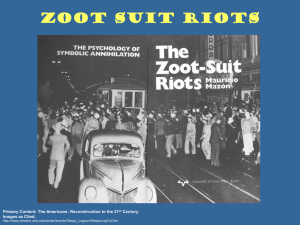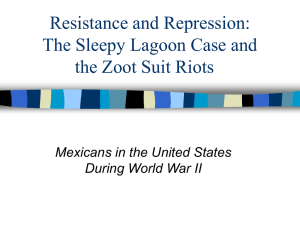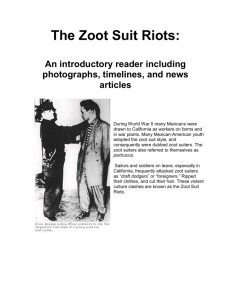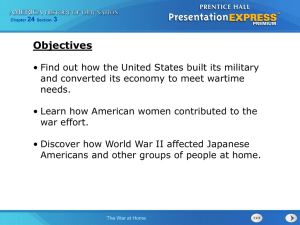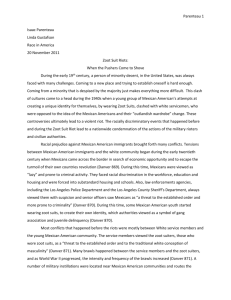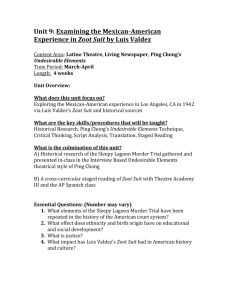U.S. History ZOOT SUIT RIOTS Central Question: What caused the
advertisement
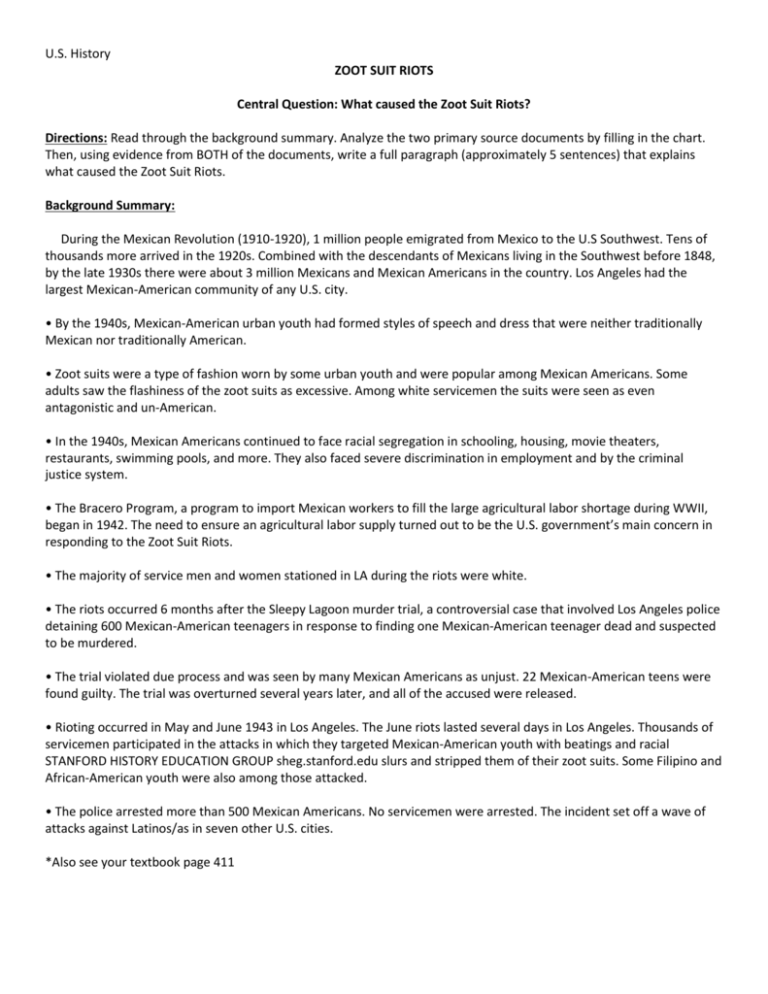
U.S. History ZOOT SUIT RIOTS Central Question: What caused the Zoot Suit Riots? Directions: Read through the background summary. Analyze the two primary source documents by filling in the chart. Then, using evidence from BOTH of the documents, write a full paragraph (approximately 5 sentences) that explains what caused the Zoot Suit Riots. Background Summary: During the Mexican Revolution (1910-1920), 1 million people emigrated from Mexico to the U.S Southwest. Tens of thousands more arrived in the 1920s. Combined with the descendants of Mexicans living in the Southwest before 1848, by the late 1930s there were about 3 million Mexicans and Mexican Americans in the country. Los Angeles had the largest Mexican-American community of any U.S. city. • By the 1940s, Mexican-American urban youth had formed styles of speech and dress that were neither traditionally Mexican nor traditionally American. • Zoot suits were a type of fashion worn by some urban youth and were popular among Mexican Americans. Some adults saw the flashiness of the zoot suits as excessive. Among white servicemen the suits were seen as even antagonistic and un-American. • In the 1940s, Mexican Americans continued to face racial segregation in schooling, housing, movie theaters, restaurants, swimming pools, and more. They also faced severe discrimination in employment and by the criminal justice system. • The Bracero Program, a program to import Mexican workers to fill the large agricultural labor shortage during WWII, began in 1942. The need to ensure an agricultural labor supply turned out to be the U.S. government’s main concern in responding to the Zoot Suit Riots. • The majority of service men and women stationed in LA during the riots were white. • The riots occurred 6 months after the Sleepy Lagoon murder trial, a controversial case that involved Los Angeles police detaining 600 Mexican-American teenagers in response to finding one Mexican-American teenager dead and suspected to be murdered. • The trial violated due process and was seen by many Mexican Americans as unjust. 22 Mexican-American teens were found guilty. The trial was overturned several years later, and all of the accused were released. • Rioting occurred in May and June 1943 in Los Angeles. The June riots lasted several days in Los Angeles. Thousands of servicemen participated in the attacks in which they targeted Mexican-American youth with beatings and racial STANFORD HISTORY EDUCATION GROUP sheg.stanford.edu slurs and stripped them of their zoot suits. Some Filipino and African-American youth were also among those attacked. • The police arrested more than 500 Mexican Americans. No servicemen were arrested. The incident set off a wave of attacks against Latinos/as in seven other U.S. cities. *Also see your textbook page 411 Document A (Modified) Near-martial law in L.A. riot zones Los Angeles Daily News June 9, 1943 Harold Tabor, 32, Long Beach sailor, was severely beaten by a gang of zooters at 103rd and Graham St. He suffered a broken nose and serious facial cuts. "I was passing a poolhall on the way to a grocery store when the gang hopped (jumped) me, " he said. Two soldiers and a Negro zoot suiter were taken into custody after a riot at the corner of Second and Spring streets. Police continued to search for others. Police ordered groups of more than three to "break it up" everywhere in the downtown area. Police officers were stationed on every corner and the city resembled martial law rule. Squads of riot breakers roamed the city, trying to solve the zoot suit problem. Navy shore patrol officers walked in and out of bars, dancehalls, drugstores, bus stations. One of the most serious outbreaks of terrorism occurred in Watts. There, three trains were stoned by pachucos. One person was cut seriously. A few minutes later, nearly every window of an outbound Long Beach two-car train was smashed when it was caught in a crossfire of pachuco stoning. Gangsterism in Watts continued into the early hours of today. Twelve Negroes ambushed a 17-year-old white high school student, asked him if he was a "zoot suiter" and when he said "no" the fight started. The victim, Joe M. Steddum of 8834 Banders St., Watts, received a five-inch cut on his left forehead. A Navy commander of the 11th Naval district in San Diego stated the following: "Until further notice, except for special occasions approved by the commanding officer, the city of Los Angeles will be out of bounds for all enlisted personnel of the naval services not attached to the stations within this city, or in travel status. Zoot suiters are being arrested in all parts of L.A. County. Many have been caught with weapons such as knives hidden in their pants. Many sailors and servicemen have victims of violence and casualties from the pachuco hoodlums. Vocabuary – Pachuco: Mexican-American zoot suiter Document B (Modified) The Battle Between Marines and Pachucos La Opinión June 9, 1943 The Coordinator of Latin-American Youths . . . informed us . . . that during a meeting in which the situation created by the riots between the "pachucos" and the marines was discussed, a decision was reached to send the following telegram to the Head of the Office of War Information in Washington and to the Head of the Division of Foreign Languages, of the same office, and to President Roosevelt at the White House. Here is the message: Since last Thursday evening various groups of marines and soldiers have attacked Mexican zoot suiters throughout the city of Los Angeles. Although the youth did nothing to provoke the attack or for that matter to resist the attack, many were severely wounded, including women and children. Supposedly the attack has been motivated by past conflicts between the two groups and has been amplified by the press claiming that Mexican youths have been disrespectful toward the servicemen, a claim without any foundation. Despite precautions taken on the part of the military police and local authorities to control the situation, the servicemen continue to walk the streets of Los Angeles armed with clubs and appear to be tacitly supported by many city and local officials in charge of keeping the peace; their attacks have now expanded to include blacks. This situation, which is prompting racial antagonism between the Mexican, Anglo-Saxon and Black communities will undoubtedly have grave international repercussions which will inevitably damage the war effort and thwart the gains made by the Good Neighbor policy. We urge immediate intervention by the Office of War Information so that it moderates the local press which has openly approved of these mutinies and which is treating this situation in a manner that is decidedly inflammatory. Vocabulary – Good Neighbor Policy: Foreign policy adopted by the US under President Franklin Roosevelt in which the US said it would not intervene in Latin American countries’ affairs Mutiny: rebellion by soldiers against the orders of their officers Name: Per: What Caused the Zoot Suit Riots? LA Times La Opinion H – Historical Context: What is happening at the time? When is it written? Who is involved? I – Intended Audience: Who is the ACTUAL or INTENDED audience? Who was meant to see, hear, or read it? P – Purpose: What is the purpose of this document? Why was it written? Point of View – POV: What is the perspective or point of view? Is it biased? O– Outside Evidence: What else is important to understand this document? What parallels or connections are evidence? According to this document, what caused the Zoot Suit Riots? Who is to blame for the violence? What evidence do they use to support their POV? Provide a quote from the document. On the back…. Using evidence from both of these documents, write a paragraph that explains what caused the Zoot Suit Riots.
